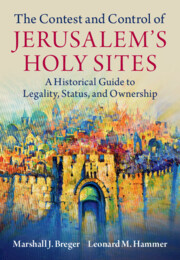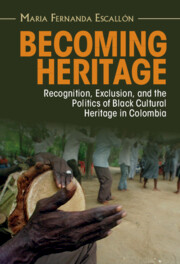55 results
How to Be a ‘Good’ Collector: Some Ethical Reflections on the Private Collecting of Cultural Heritage
-
- Journal:
- International Journal of Cultural Property , First View
- Published online by Cambridge University Press:
- 13 May 2024, pp. 1-17
-
- Article
-
- You have access
- Open access
- HTML
- Export citation
Indigenous peoples at the heritage–climate change nexus: Examining the effectiveness of UNESCO and the IPCC’s boundary work
-
- Journal:
- Review of International Studies , First View
- Published online by Cambridge University Press:
- 08 March 2024, pp. 1-22
-
- Article
-
- You have access
- Open access
- HTML
- Export citation
19 - Protecting Cultural Heritage during an Occupation
- from Part VII - Cultural Heritage Law and Law of the Sea
-
-
- Book:
- International Courts versus Non-Compliance Mechanisms
- Published online:
- 15 February 2024
- Print publication:
- 22 February 2024, pp 445-470
-
- Chapter
-
- You have access
- Open access
- HTML
- Export citation
Epilogue: Beyond 1933
-
- Book:
- Feeding the Mind
- Published online:
- 07 October 2023
- Print publication:
- 05 October 2023, pp 227-245
-
- Chapter
- Export citation
7 - Cheikh Anta Diop’s Recovery of Egypt: African History as Anticolonial Practice
- from Part II - Solidarities and Their Discontents
-
-
- Book:
- The Anticolonial Transnational
- Published online:
- 10 August 2023
- Print publication:
- 24 August 2023, pp 135-161
-
- Chapter
- Export citation

The Contest and Control of Jerusalem's Holy Sites
- A Historical Guide to Legality, Status, and Ownership
-
- Published online:
- 27 July 2023
- Print publication:
- 17 August 2023
When low level of constraint and effectiveness go hand in hand: The example of the 2005 Convention
-
- Journal:
- International Journal of Cultural Property / Volume 30 / Issue 1 / February 2023
- Published online by Cambridge University Press:
- 08 June 2023, pp. 62-82
-
- Article
-
- You have access
- Open access
- HTML
- Export citation
2 - The Nature, Scope and Protection of Artistic Freedom
-
- Book:
- Artistic Freedom in International Law
- Published online:
- 06 April 2023
- Print publication:
- 13 April 2023, pp 38-67
-
- Chapter
- Export citation
4 - Positive Obligations in Relation to Artistic Freedom
-
- Book:
- Artistic Freedom in International Law
- Published online:
- 06 April 2023
- Print publication:
- 13 April 2023, pp 99-127
-
- Chapter
- Export citation

Becoming Heritage
- Recognition, Exclusion, and the Politics of Black Cultural Heritage in Colombia
-
- Published online:
- 06 April 2023
- Print publication:
- 13 April 2023
“We are not in Geneva on the Human Rights Council”: Indigenous peoples’ experiences with the World Heritage Convention
-
- Journal:
- International Journal of Cultural Property / Volume 29 / Issue 4 / November 2022
- Published online by Cambridge University Press:
- 29 March 2023, pp. 487-530
-
- Article
-
- You have access
- Open access
- HTML
- Export citation
Inventing the ‘Maritime Silk Road’
-
- Journal:
- Modern Asian Studies / Volume 57 / Issue 4 / July 2023
- Published online by Cambridge University Press:
- 22 March 2023, pp. 1059-1104
- Print publication:
- July 2023
-
- Article
-
- You have access
- Open access
- HTML
- Export citation
7 - Natural Law and the Universal Declaration of Human Rights
- from Part I - Natural Law and the Origins of Human Rights
-
-
- Book:
- The Cambridge Handbook of Natural Law and Human Rights
- Published online:
- 03 November 2022
- Print publication:
- 17 November 2022, pp 100-116
-
- Chapter
- Export citation
15 - How to Escape the Sovereignty Trap: Lessons and Limitations of the European Union Model
- from Part IV - The Middle-Term Goal: New International Tools for the Late Twenty-First Century
-
- Book:
- Planet in Peril
- Published online:
- 13 October 2022
- Print publication:
- 13 October 2022, pp 212-232
-
- Chapter
- Export citation
9 - The Dynamics of Repetition
- from Part III - Innovative Concepts
-
-
- Book:
- Conceptualizing International Practices
- Published online:
- 09 June 2022
- Print publication:
- 23 June 2022, pp 193-212
-
- Chapter
- Export citation
19 - Human Dignity, Life Sciences Technologies and the Renewed Imperative to Preserve Human Freedom
- from Part III - Towards a Convergence
-
-
- Book:
- The Cambridge Handbook of Information Technology, Life Sciences and Human Rights
- Published online:
- 17 May 2022
- Print publication:
- 26 May 2022, pp 273-285
-
- Chapter
- Export citation
1 - History and Testimony at the House of Slaves
-
- Book:
- Decolonizing Heritage
- Published online:
- 10 March 2022
- Print publication:
- 17 March 2022, pp 39-72
-
- Chapter
- Export citation
Introduction
-
- Book:
- Decolonizing Heritage
- Published online:
- 10 March 2022
- Print publication:
- 17 March 2022, pp 13-38
-
- Chapter
- Export citation
Cultural evolution: Protecting “digital cultural property” in armed conflict
-
- Journal:
- International Review of the Red Cross / Volume 104 / Issue 919 / April 2022
- Published online by Cambridge University Press:
- 04 March 2022, pp. 1083-1119
-
- Article
- Export citation
13 - From Human Welfare to Human Rights
- from Part III - Social Rights in the Age of Internationalism
-
-
- Book:
- Social Rights and the Politics of Obligation in History
- Published online:
- 11 January 2022
- Print publication:
- 06 January 2022, pp 243-263
-
- Chapter
- Export citation



